Retrieving Land Surface Temperature from Hyperspectral Thermal Infrared Data Using a Multi-Channel Method
Abstract
:1. Introduction
2. Methodology
2.1. Multi-Channel Method
2.2. Adaptation for Natural Land Surfaces
2.2.1. Adapted Multi-Channel Method
2.2.2. Analysis of the Variation in LSE
2.2.3. Determination of Central Wavenumbers of the Channels
2.2.4. Determination of the αi Coefficients
3. Sensitivity Analysis
3.1. Sensitivity to Land Surface Emissivity
3.2. Sensitivity to Instrumental Noise
4. Evaluation
4.1. With Independent Simulation Data
4.2. With Satellite Data
5. Conclusions
- (1)
- LST can be retrieved by the adapted multi-channel method from the simulation data with an RMSE of 0.90 K using hyperspectral thermal infrared data from only 36 channels.
- (2)
- As the minimum LSE in the spectral interval of 800–950 cm−1 decreases from 0.98 to 0.95, the error of the LSTs retrieved by the adapted multi-channel method for the simulation data with the corresponding LSE condition increases from 0.85 K to 1.25 K. In addition, the impact of the instrumental noise is approximately three times its magnitude.
- (3)
- The difference between the LST retrieved by the adapted multi-channel method from the IASI/Metop-A data and the LST product from the SEVIRI/Meteosat is approximately 1.6 K on average.
Acknowledgments
Author Contributions
Conflicts of Interest
Abbreviations
| LST | Land Surface Temperature |
| LSE | Land Surface Emissivity |
| TES | Temperature and Emissivity Separation |
| TRSM | the Two Step Retrieval method |
| TOA | Top of Atmosphere |
| 4A/OP | Operational release for Automatized Atmospheric Absorption Atlas |
| TIGR | Thermodynamic Initial Guess Retrieval |
| NE∆T | Noise Equivalent Temperature Difference |
| IASI | the Infrared Atmospheric Sounding Interferometer |
| CrIS | the Cross-track Infrared Sounder |
| SEVIRI | the Spinning Enhanced Visible and Infrared Imager |
| ANN | Artificial Neural Network |
| RMSE | the Root Mean Square Error |
References
- Zhou, L.; Dickinson, R.E.; Tian, Y.; Jin, M.; Ogawa, K.; Yu, H.; Schmugge, T. A sensitivity study of climate and energy balance simulations with use of satellite-derived emissivity data over northern africa and the arabian peninsula. J. Geophys. Res. 2003, 108. [Google Scholar] [CrossRef]
- Le Marshall, J.; Jung, J.; Derber, J.; Chahine, M.; Treadon, R.; Lord, S.J.; Goldberg, M.; Wolf, W.; Liu, H.C.; Joiner, J.; et al. Improving global analysis and forecasting with airs. Bull. Am. Meteorol. Soc. 2006, 87, 891–894. [Google Scholar] [CrossRef]
- Vandenbussche, S.; Kochenova, S.; Vandaele, A.C.; Kumps, N.; De Maziere, M. Retrieval of desert dust aerosol vertical profiles from IASI measurements in the tir atmospheric window. Atmos. Meas. Tech. 2013, 6, 2577–2591. [Google Scholar] [CrossRef]
- Rhee, J.; Im, J.; Carbone, G.J. Monitoring agricultural drought for arid and humid regions using multi-sensor remote sensing data. Remote Sens. Environ. 2010, 114, 2875–2887. [Google Scholar] [CrossRef]
- Duan, S.-B.; Li, Z.-L.; Tang, B.-H.; Wu, H.; Tang, R. Direct estimation of land-surface diurnal temperature cycle model parameters from msg-seviri brightness temperatures under clear sky conditions. Remote Sens. Environ. 2014, 150, 34–43. [Google Scholar] [CrossRef]
- Duan, S.-B.; Li, Z.-L.; Tang, B.-H.; Wu, H.; Tang, R. Generation of a time-consistent land surface temperature product from modis data. Remote Sens. Environ. 2014, 140, 339–349. [Google Scholar] [CrossRef]
- Goldberg, M.D.; Qu, Y.N.; McMillin, L.M.; Wolf, W.; Zhou, L.H.; Divakarla, M. Airs near-real-time products and algorithms in support of operational numerical weather prediction. IEEE Trans. Geosci. Remote Sens. 2003, 41, 379–389. [Google Scholar] [CrossRef]
- Li, Z.-L.; Tang, B.-H.; Wu, H.; Ren, H.; Yan, G.; Wan, Z.; Trigo, I.F.; Sobrino, J.A. Satellite-derived land surface temperature: Current status and perspectives. Remote Sens. Environ. 2013, 131, 14–37. [Google Scholar] [CrossRef]
- Dash, P.; Gottsche, F.M.; Olesen, F.S.; Fischer, H. Land surface temperature and emissivity estimation from passive sensor data: Theory and practice-current trends. Int. J. Remote Sens. 2002, 23, 2563–2594. [Google Scholar] [CrossRef]
- Hook, S.J.; Gabell, A.R.; Green, A.A.; Kealy, P.S. A comparison of techniques for extracting emissivity information from thermal infrared data for geologic studies. Remote Sens. Environ. 1992, 42, 123–135. [Google Scholar] [CrossRef]
- McMillin, L.M. Estimation of sea surface temperatures from two infrared window measurements with different absorption. J. Geophys. Res. 1975, 80, 5113–5117. [Google Scholar] [CrossRef]
- Tang, B.-H.; Bi, Y.Y.; Li, Z.-L.; Xia, J. Generalized Split-Window algorithm for estimate of Land surface temperature from Chinese geostationary FengYun meterological satellite (FY-2C) data. Sensors 2008, 8, 933–951. [Google Scholar] [CrossRef]
- Rozenstein, O.; Qin, Z.H.; Derimian, Y.; Karnieli, A. Derivation of land surface temperature for Landsat-8 TIRS using a split window algorithm. Sensors 2014, 14, 5768–5780. [Google Scholar] [CrossRef] [PubMed]
- Xia, L.; Mao, K.; Ma, Y.; Zhao, F.; Jiang, L.; Shen, X.; Qin, Z. An Algorithm for Retrieving Land Surface Temperatures Using VIIRS Data in Combination with Multi-Sensors. Sensors 2014, 14, 21385–21408. [Google Scholar] [CrossRef] [PubMed]
- Sun, D.L.; Pinker, R.T. Estimation of land surface temperature from a geostationary operational environmental satellite (goes-8). J. Geophys. Res. 2003, 108. [Google Scholar] [CrossRef]
- Sun, D.; Pinker, R.T. Implementation of goes-based land surface temperature diurnal cycle to avhrr. Int. J. Remote Sens. 2005, 26, 3975–3984. [Google Scholar] [CrossRef]
- Sun, D.; Pinker, R.T. Retrieval of surface temperature from the msg-seviri observations: Part I. Methodology. Int. J. Remote Sens. 2007, 28, 5255–5272. [Google Scholar] [CrossRef]
- Chedin, A.; Scott, N.A.; Berroir, A. A single-channel, double-viewing angle method for sea-surface temperature determination from coincident meteosat and tiros-n radiometric measurements. J. Appl. Meteorol. 1982, 21, 613–618. [Google Scholar] [CrossRef]
- Wan, Z.M.; Li, Z.L. A physics-based algorithm for retrieving land-surface emissivity and temperature from eos/modis data. IEEE Trans. Geosci. Remote Sensing 1997, 35, 980–996. [Google Scholar]
- Gillespie, A.; Rokugawa, S.; Matsunaga, T.; Cothern, J.S.; Hook, S.; Kahle, A.B. A temperature and emissivity separation algorithm for advanced spaceborne thermal emission and reflection radiometer (aster) images. IEEE Trans. Geosci. Remote Sens. 1998, 36, 1113–1126. [Google Scholar] [CrossRef]
- Li, J.; Li, Z.; Jin, X.; Schmit, T.J.; Zhou, L.; Goldberg, M.D. Land surface emissivity from high temporal resolution geostationary infrared imager radiances: Methodology and simulation studies. J. Geophys. Res. 2011, 116, D1. [Google Scholar] [CrossRef]
- Masiello, G.; Serio, C.; De Feis, I.; Amoroso, M.; Venafra, S.; Trigo, I.F.; Watts, P. Kalman filter physical retrieval of surface emissivity and temperature from geostationary infrared radiances. Atmos. Meas. Tech. 2013, 6, 3613–3634. [Google Scholar] [CrossRef]
- Ma, X.L.; Wan, Z.M.; Moeller, C.C.; Menzel, W.P.; Gumley, L.E.; Zhang, Y.L. Retrieval of geophysical parameters from moderate resolution imaging spectroradiometer thermal infrared data: Evaluation of a two-step physical algorithm. Appl. Opt. 2000, 39, 3537–3550. [Google Scholar] [CrossRef] [PubMed]
- Ma, X.L.; Wan, Z.M.; Moeller, C.C.; Menzel, W.P.; Gumley, L.E. Simultaneous retrieval of atmospheric profiles, land-surface temperature, and surface emissivity from moderate-resolution imaging spectroradiometer thermal infrared data: Extension of a two-step physical algorithm. Appl. Opt. 2002, 41, 909–924. [Google Scholar] [CrossRef] [PubMed]
- Trigo, I.F.; Peres, L.F.; DaCarnara, C.C.; Freitas, S.C. Thermal land surface emissivity retrieved from seviri/meteosat. IEEE Trans. Geosci. Remote Sens. 2008, 46, 307–315. [Google Scholar] [CrossRef]
- Sobrino, J.A.; Jiménez-Muñoz, J.C. Land surface temperature retrieval from thermal infrared data: An assessment in the context of the Surface Processes and Ecosystem Changes through Response Analysis (SPECTRA) mission. J. Geophys. Res. 2005, 110, D16103. [Google Scholar] [CrossRef]
- Wan, Z.; Li, Z.L. Radiance-based validation of the v5 modis land-surface temperature product. Int. J. Remote Sens. 2008, 29, 5373–5395. [Google Scholar] [CrossRef]
- Gillespie, A.R.; Abbott, E.A.; Gilson, L.; Hulley, G.; Jimenez-Munoz, J.-C.; Sobrino, J.A. Residual errors in aster temperature and emissivity standard products ast08 and ast05. Remote Sens. Environ. 2011, 115, 3681–3694. [Google Scholar] [CrossRef]
- August, T.; Klaes, D.; Schlüssel, P.; Hultberg, T.; Crapeau, M.; Arriaga, A.; O’Carroll, A.; Coppens, D.; Munro, R.; Calbet, X. IASI on Metop-A: Operational Level 2 retrievals after five years in orbit. J. Quant. Spectrosc. Radiat. Transf. 2012, 113, 1340–1371. [Google Scholar] [CrossRef]
- Hilton, F.; Armante, R.; August, T.; Barnet, C.; Bouchard, A.; Camy-Peyret, C.; Zhou, D. Hyperspectral Earth Observation from IASI: Five Years of Accomplishments. Am. Meteor. Soc. 2012, 93, 347–370. [Google Scholar] [CrossRef]
- Bloom, H.J. The cross-track infrared sounder (cris): A sensor for operational meteorological remote sensing. In Proceedings of the IEEE 2001 International Geoscience and Remote Sensing Symposium, 2001. IGARSS’01, Sydney, Australia, 2001; Volume 3, pp. 1341–1343.
- Schlussel, P.; Goldberg, M. Retrieval of atmospheric temperature and water vapour from IASI measurements in partly cloudy situations. Adv. Space Res. 2002, 29, 1703–1706. [Google Scholar] [CrossRef]
- Zhou, D.K.; Smith, W.L.; Li, J.; Howell, H.B.; Cantwell, G.W.; Larar, A.M.; Knuteson, R.O.; Tobin, D.C.; Revercomb, H.E.; Mango, S.A. Thermodynamic product retrieval methodology and validation for nast-i. Appl. Opt. 2002, 41, 6957–6967. [Google Scholar] [CrossRef] [PubMed]
- Weisz, E.; Thapliyal, P.; Guan, L.; Huang, H.-L.; Li, J.; Borbas, E.; Baggett, K. International modis and airs processing package: Airs products and applications. J. Appl. Remote Sens. 2007, 1, 013519–013523. [Google Scholar] [CrossRef]
- Zhou, D.K.; Larar, A.M.; Liu, X.; Smith, W.L.; Strow, L.L.; Yang, P.; Schluessel, P.; Calbet, X. Global land surface emissivity retrieved from satellite ultraspectral ir measurements. IEEE Trans. Geosci. Remote Sens. 2011, 49, 1277–1290. [Google Scholar] [CrossRef]
- Aires, F.; Chedin, A.; Scott, N.A.; Rossow, W.B. A regularized neural net approach for retrieval of atmospheric and surface temperatures with the IASI instrument. J. Appl. Meteorol. Climatol. 2002, 41, 144–159. [Google Scholar] [CrossRef]
- Wang, N.; Li, Z.-L.; Tang, B.-H.; Zeng, F.; Li, C. Retrieval of atmospheric and land surface parameters from satellite-based thermal infrared hyperspectral data using a neural network technique. Int. J. Remote Sens. 2013, 34, 3485–3502. [Google Scholar] [CrossRef]
- Zhong, X.; Labed, J.; Zhou, G.; Shao, K.; Li, Z.L. A Multi-Channel Method for Retrieving Surface Temperature for High-Emissivity Surfaces from Hyperspectral Thermal Infrared Images. Sensors 2015, 15, 13406–13423. [Google Scholar] [CrossRef] [PubMed]
- Pequignot, E.; Chedin, A.; Scott, N.A. Infrared continental surface emissivity spectra retrieved from airs hyperspectral sensor. J. Appl. Meteorol. Climatol. 2008, 47, 1619–1633. [Google Scholar] [CrossRef]
- Paul, M.; Aires, F.; Prigent, C.; Trigo, I.F.; Bernardo, F. An innovative physical scheme to retrieve simultaneously surface temperature and emissivities using high spectral infrared observations from IASI. J. Geophys. Res. 2012, 117. [Google Scholar] [CrossRef] [Green Version]
- Rodgers, C.D. Retrieval of atmospheric temperature and composition from remote measurements of thermal radiation. Rev. Geophys. 1976, 14, 609–624. [Google Scholar] [CrossRef]
- Li, J.; Li, J.; Weisz, E.; Zhou, D.K. Physical retrieval of surface emissivity spectrum from hyperspectral infrared radiances. Geophys. Res. Lett. 2007, 34. [Google Scholar] [CrossRef]
- Wang, N. Simultaneous Retrieval of Land Surface Temperature, Emissivity and Atmospheric Profiles from Hyperspectral Thermal Infrared Data. Doctoral Dissertation, Chinese Academy of Sciences, Beijing, China, 22 May 2011. [Google Scholar]
- Masiello, G.; Serio, C. Simultaneous physical retrieval of surface emissivity spectrum and atmospheric parameters from infrared atmospheric sounder interferometer spectral radiances. Appl. Opt. 2013, 52, 2428–2446. [Google Scholar] [CrossRef] [PubMed]
- Scott, N.; Chedin, A. A fast line-by-line method for atmospheric absorption computations: The automatized atmospheric absorption atlas. J. Appl. Meteorol. Climatol. 1981, 20, 802–812. [Google Scholar] [CrossRef]
- Chaumat, L.; Standfuss, C.; Tournier, B.; Armante, R.; Scott, N. 4a/op Reference Documentation; NOV-3049-NT-1178-v4. 0; NOVELTIS, LMD/CNRS, CNES: Toulouse, France, 2009. [Google Scholar]
- Chedin, A.; Scott, N.A.; Wahiche, C.; Moulinier, P. The improved initialization inversion method—A high-resolution physical method for temperature retrievals from satellites of the tiros-n series. J. Appl. Meteorol. Climatol. 1985, 24, 128–143. [Google Scholar] [CrossRef]
- Chevallier, F.; Cheruy, F.; Scott, N.; Chedin, A. A neural network approach for a fast and accurate computation of a longwave radiative budget. J. Appl. Meteorol. 1998, 37, 1385–1397. [Google Scholar] [CrossRef]
- Wan, Z.M.; Dozier, J. A generalized split-window algorithm for retrieving land-surface temperature from space. IEEE Trans. Geosci. Remote Sens. 1996, 34, 892–905. [Google Scholar]
- Caselles, V.; Valor, E.; Coll, C.; Rubio, E. Thermal band selection for the prism instrument. 1. Analysis of emissivity-temperature separation algorithms. J. Geophys. Res.-Atmos. 1997, 102, 11145–11164. [Google Scholar] [CrossRef]
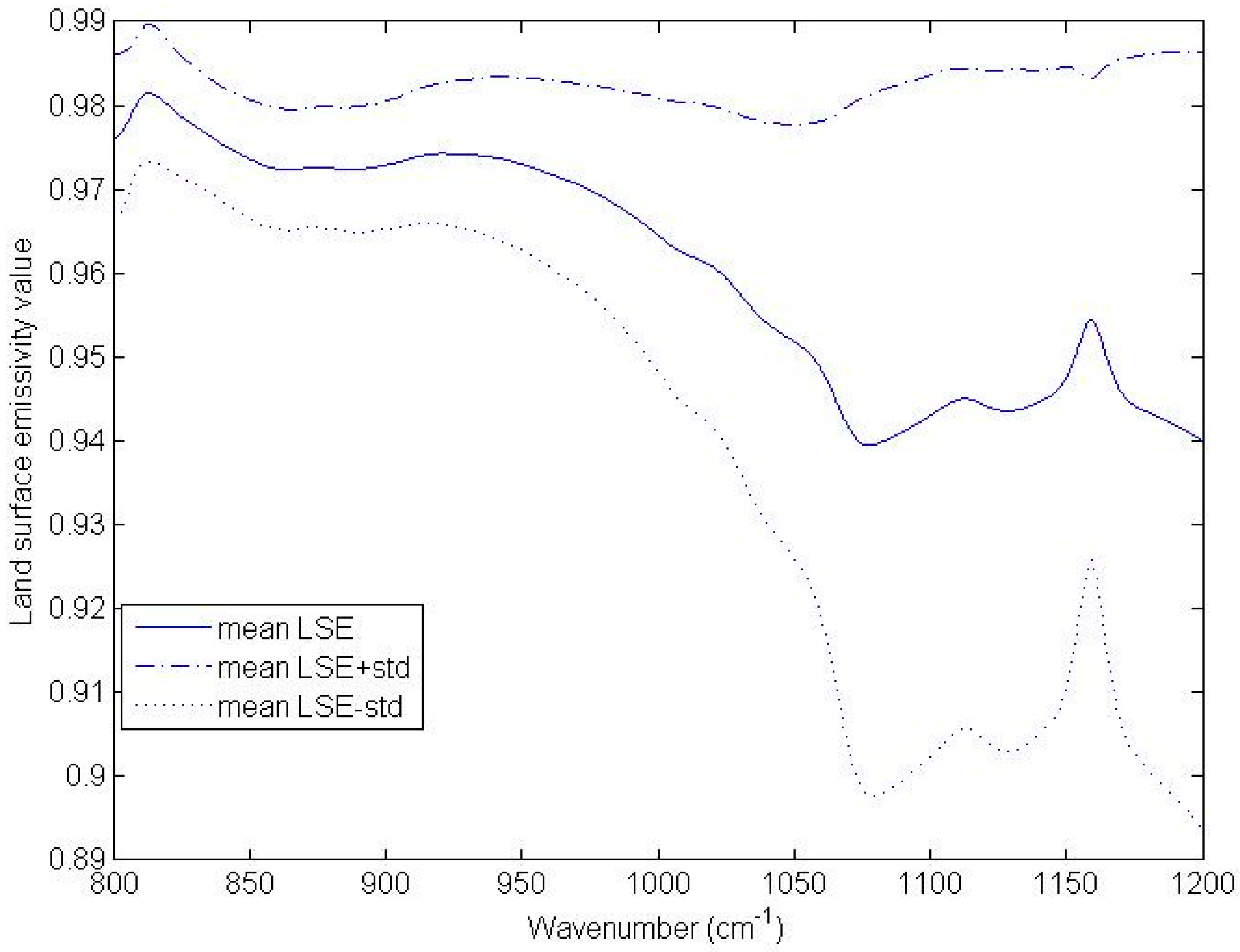
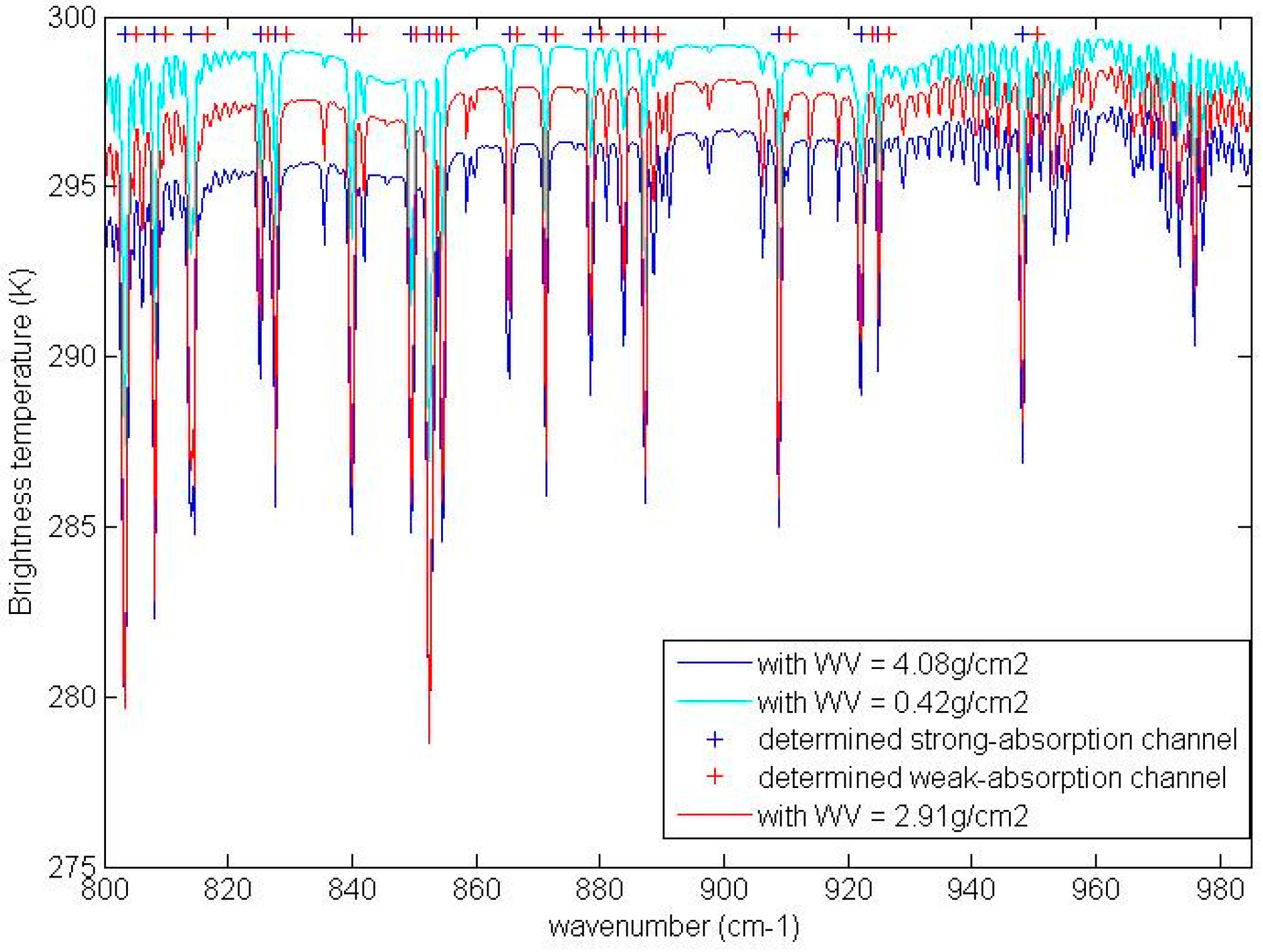

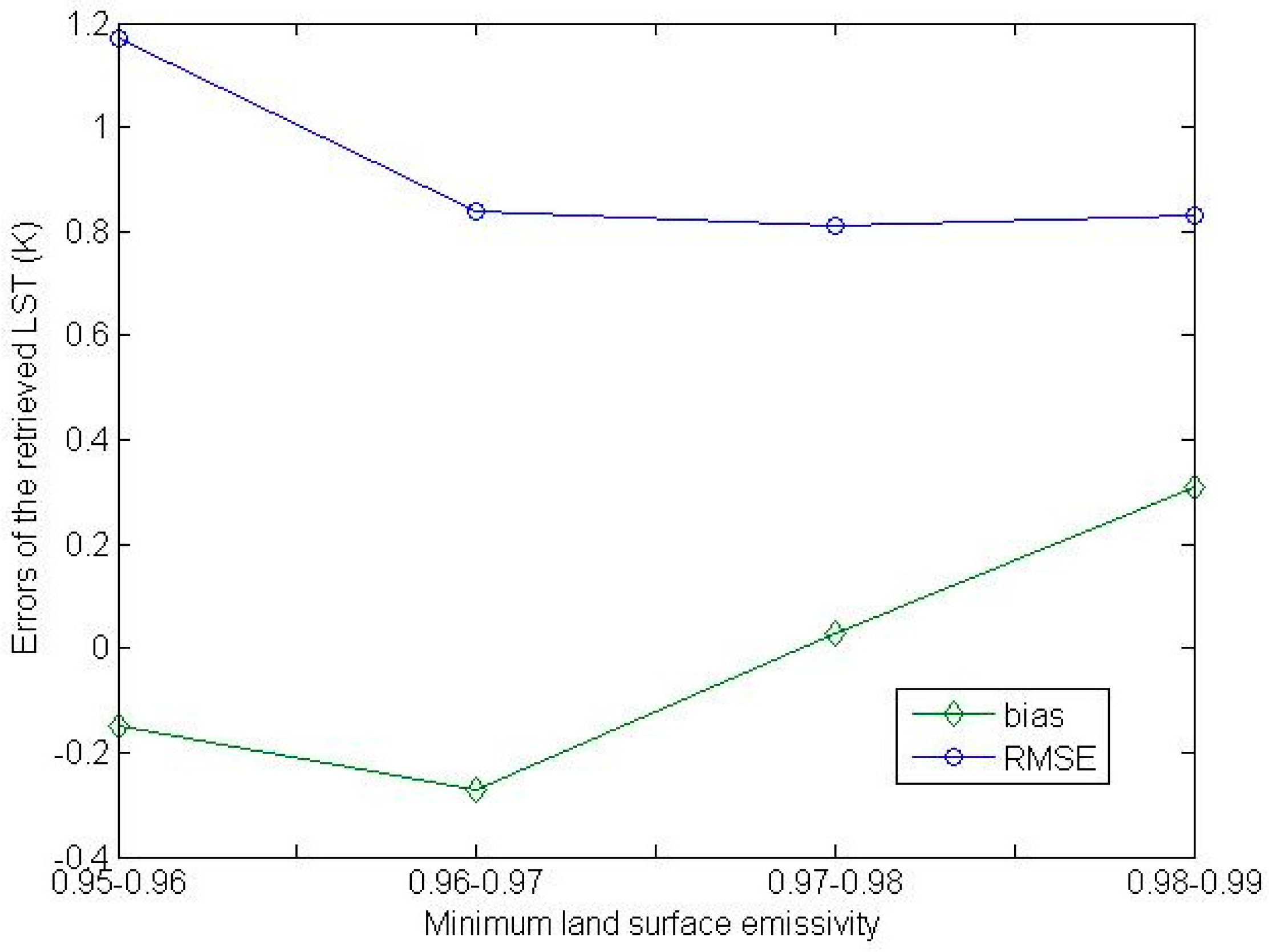
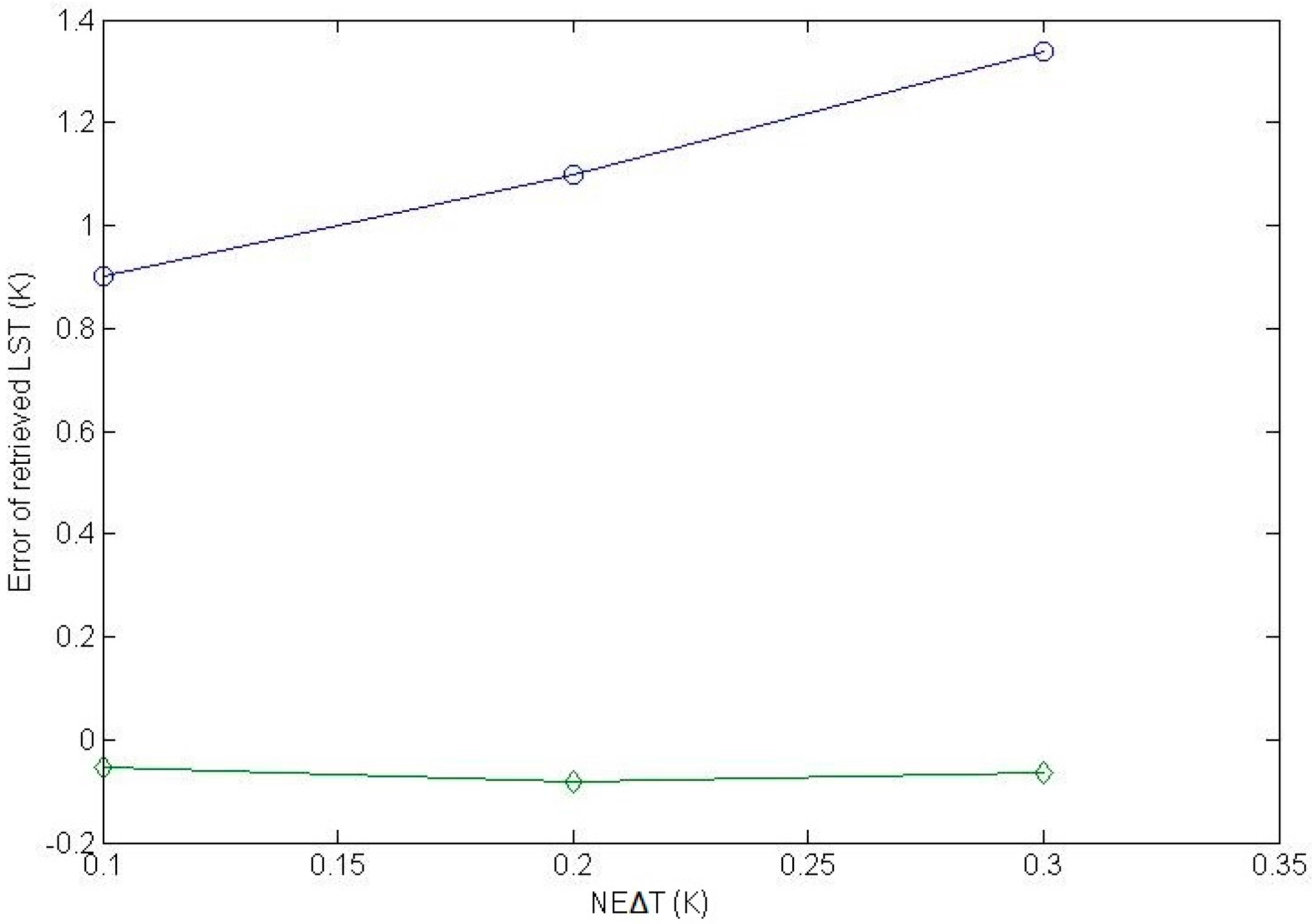

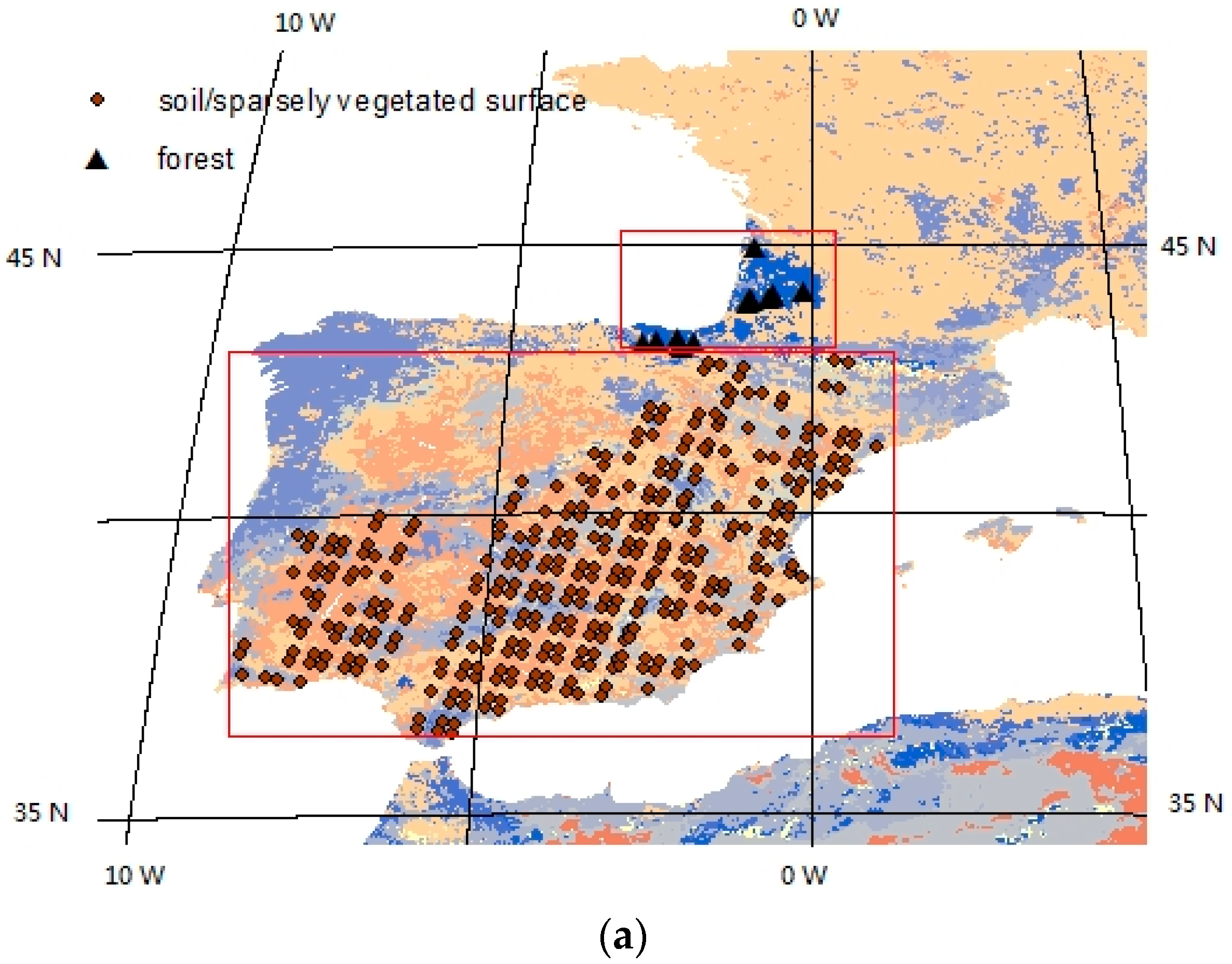
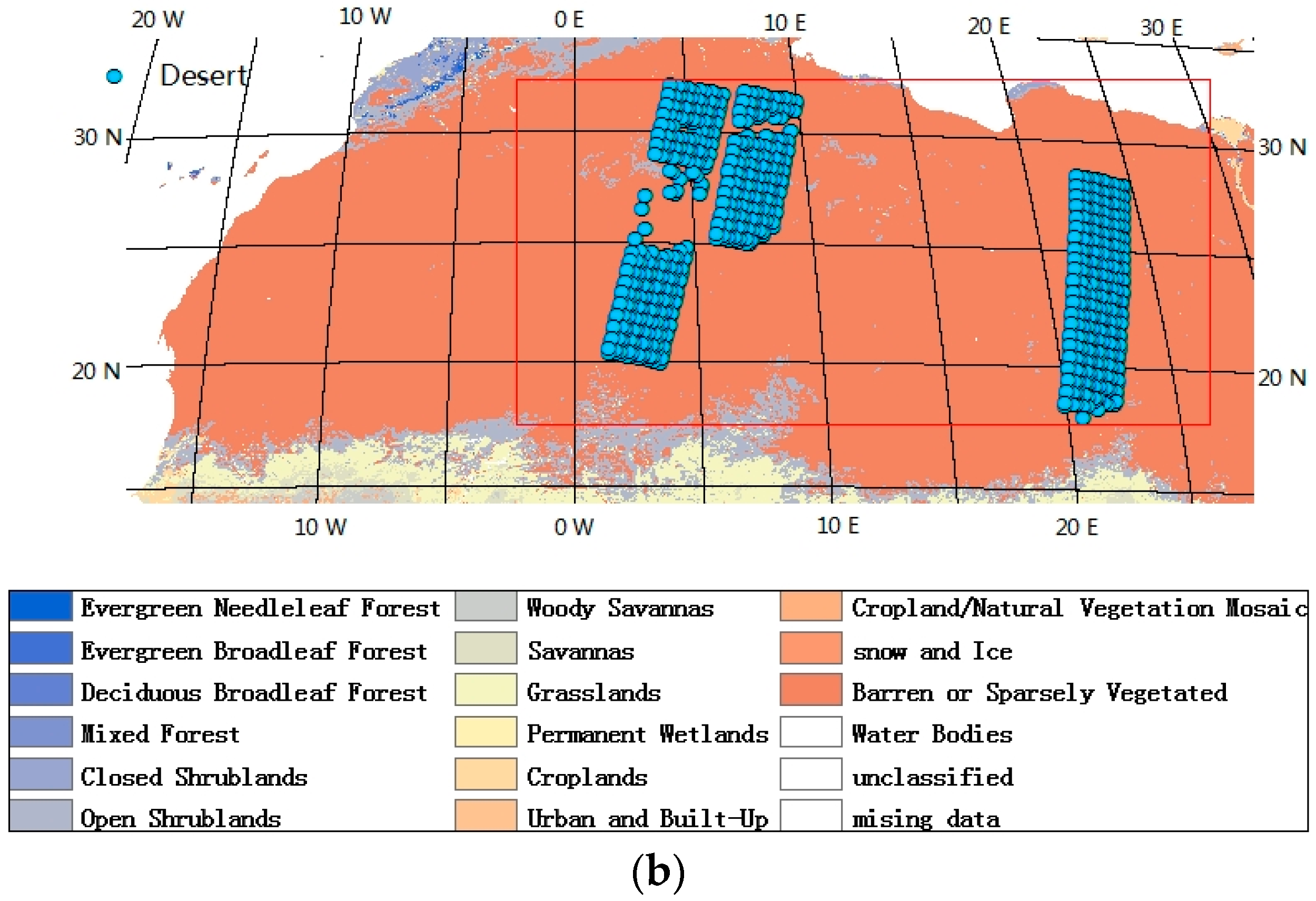

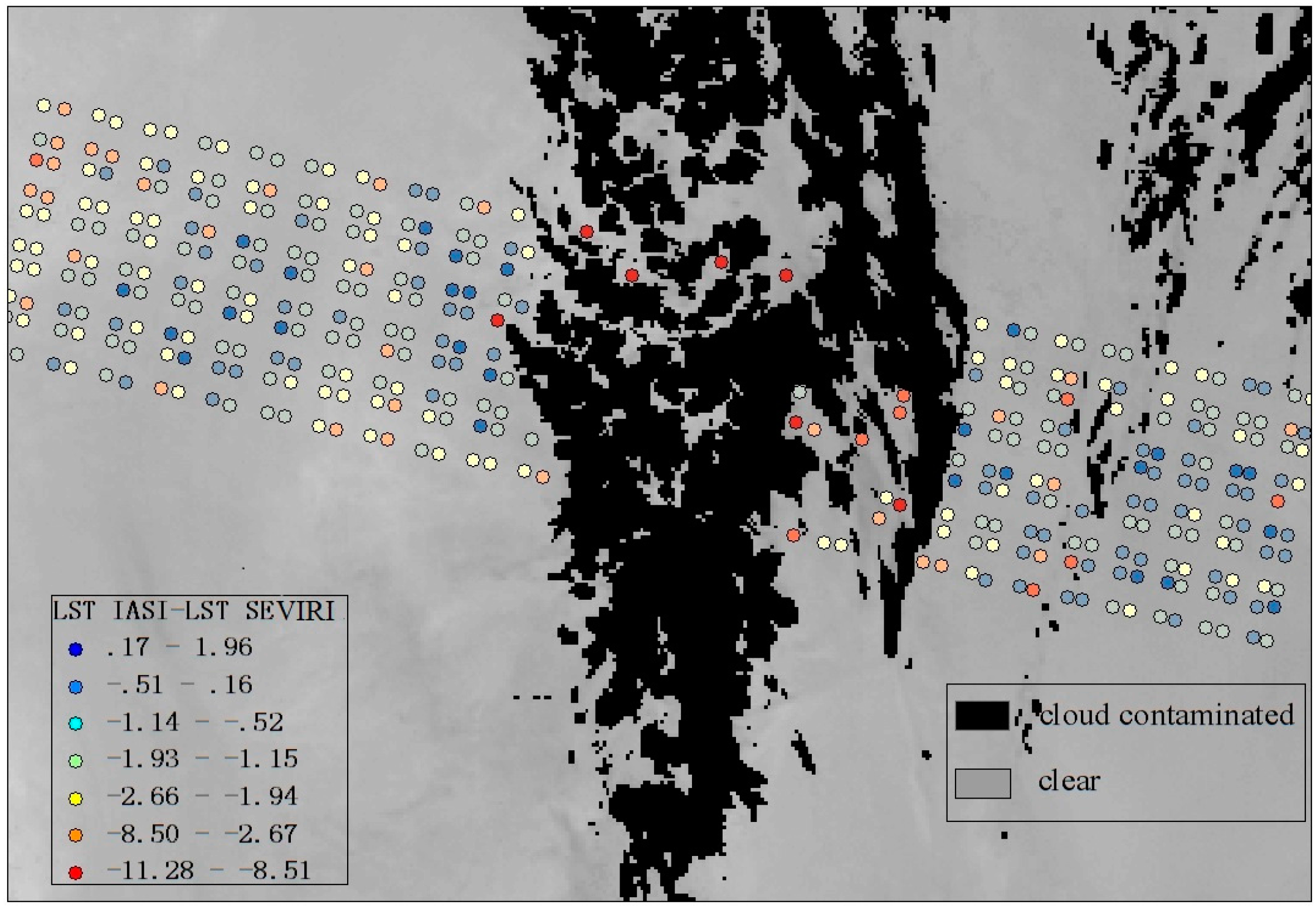
| No. of Database | 1 | 2 | 3 | 4 |
|---|---|---|---|---|
| Minimum channel LSE values | [0.95, 0.96] | [0.96, 0.97] | [0.97, 0.98] | [0.98, 0.99] |
| Target Area | Sensing Time 1 | Sensing Time 2 | Sensing Time 3 |
|---|---|---|---|
| the Sahara desert | 2014-08-01 08:15 | 2014-05-03 09:15 | 2014-11-02 09:30 |
| the forest areas | 2015-04-05 21:00 | 2015-08-09 20:55 | 2015-10-25 21:02 |
| the Iberian Peninsula | 2014-05-05 10:10 | 2014-08-09 10:30 | 2014-11-10 10:00 |
© 2016 by the authors; licensee MDPI, Basel, Switzerland. This article is an open access article distributed under the terms and conditions of the Creative Commons Attribution (CC-BY) license (http://creativecommons.org/licenses/by/4.0/).
Share and Cite
Zhong, X.; Huo, X.; Ren, C.; Labed, J.; Li, Z.-L. Retrieving Land Surface Temperature from Hyperspectral Thermal Infrared Data Using a Multi-Channel Method. Sensors 2016, 16, 687. https://doi.org/10.3390/s16050687
Zhong X, Huo X, Ren C, Labed J, Li Z-L. Retrieving Land Surface Temperature from Hyperspectral Thermal Infrared Data Using a Multi-Channel Method. Sensors. 2016; 16(5):687. https://doi.org/10.3390/s16050687
Chicago/Turabian StyleZhong, Xinke, Xing Huo, Chao Ren, Jelila Labed, and Zhao-Liang Li. 2016. "Retrieving Land Surface Temperature from Hyperspectral Thermal Infrared Data Using a Multi-Channel Method" Sensors 16, no. 5: 687. https://doi.org/10.3390/s16050687







